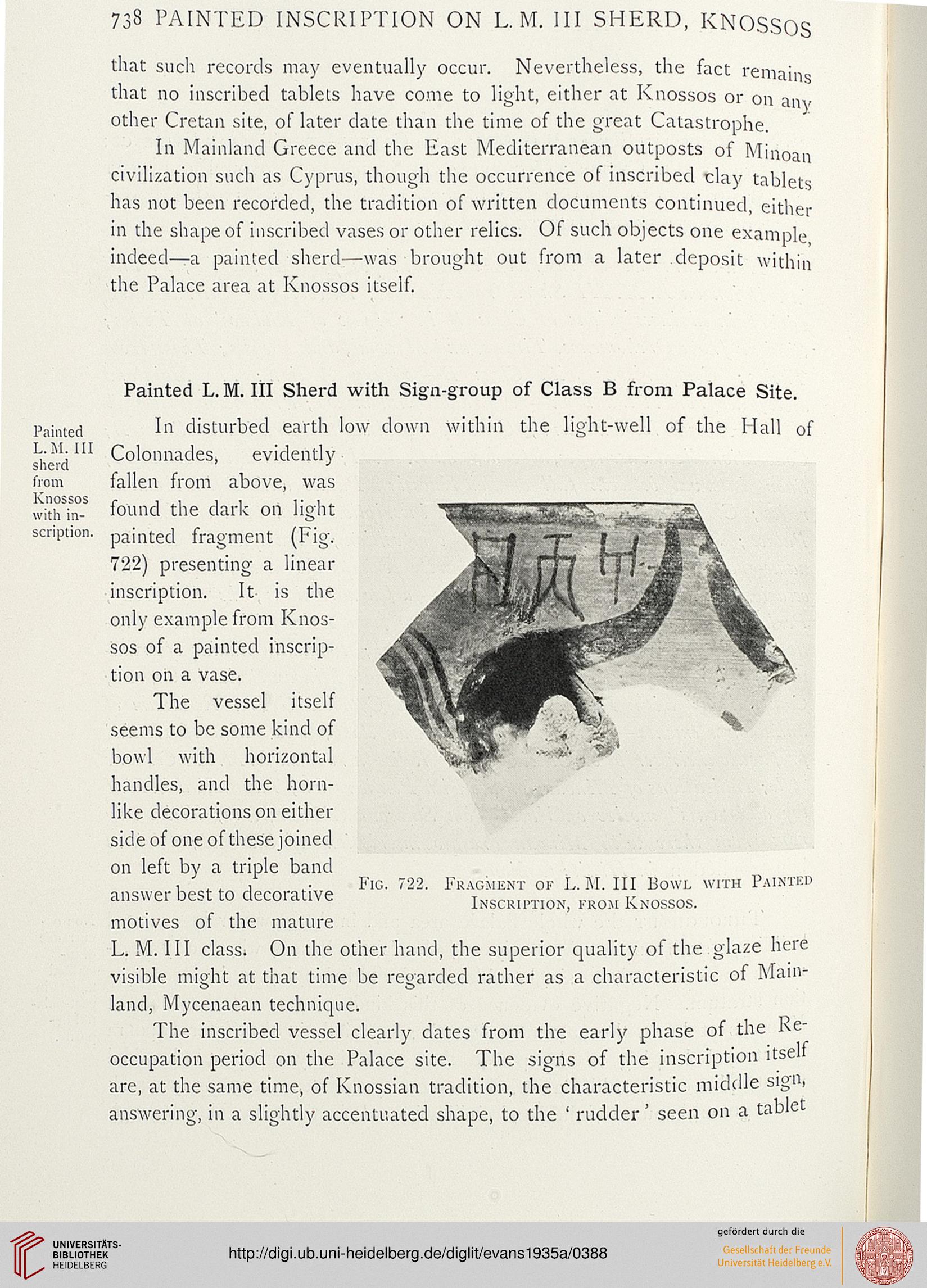738 PAINTED INSCRIPTION ON L. M. Ill SHERD, KNOSSOS
that such records may eventually occur. Nevertheless, the fact
remains
on any
that no inscribed tablets have come to light, either at Knossos or
other Cretan site, oflater date than the time of the great Catastrophe.
In Mainland Greece and the East Mediterranean outposts of Minoan
civilization such as Cyprus, though the occurrence of inscribed clay tablets
has not been recorded, the tradition of written documents continued, either
in the shape of inscribed vases or other relics. Of such objects one example
indeed—a painted sherd—was brought out from a later deposit within
the Palace area at Knossos itself.
Painted
L.M. Ill
sherd
from
Knossos
with in-
scription.
Painted L. M. Ill Sherd with Sign-group of Class B from Palace Site.
In disturbed earth low down within the light-well of the Hall of
Colonnades, evidently
fallen from above, was
found the dark on light
painted fragment (Fig.
722) presenting a linear
inscription. It is the
only example from Knos-
sos of a painted inscrip-
tion on a vase.
The vessel itself
seems to be some kind of
bowl with horizontal
handles, and the horn-
like decorations on either
side of one of these joined
on left by a triple band
answer best to decorative
motives of the mature
L. M. HI class. On the other hand, the superior quality of the glaze here
visible might at that time be regarded rather as a characteristic of Main-
land, Mycenaean technique.
The inscribed vessel clearly dates from the early phase of the In-
occupation period on the Palace site. The signs of the inscription itselt
are, at the same time, of Knossian tradition, the characteristic middle sign,
answering, in a slightly accentuated shape, to the ' rudder' seen on a table
Fig. 722. Fragment of L. M. Ill Bowl with Painted
Inscription, from Knossos.
that such records may eventually occur. Nevertheless, the fact
remains
on any
that no inscribed tablets have come to light, either at Knossos or
other Cretan site, oflater date than the time of the great Catastrophe.
In Mainland Greece and the East Mediterranean outposts of Minoan
civilization such as Cyprus, though the occurrence of inscribed clay tablets
has not been recorded, the tradition of written documents continued, either
in the shape of inscribed vases or other relics. Of such objects one example
indeed—a painted sherd—was brought out from a later deposit within
the Palace area at Knossos itself.
Painted
L.M. Ill
sherd
from
Knossos
with in-
scription.
Painted L. M. Ill Sherd with Sign-group of Class B from Palace Site.
In disturbed earth low down within the light-well of the Hall of
Colonnades, evidently
fallen from above, was
found the dark on light
painted fragment (Fig.
722) presenting a linear
inscription. It is the
only example from Knos-
sos of a painted inscrip-
tion on a vase.
The vessel itself
seems to be some kind of
bowl with horizontal
handles, and the horn-
like decorations on either
side of one of these joined
on left by a triple band
answer best to decorative
motives of the mature
L. M. HI class. On the other hand, the superior quality of the glaze here
visible might at that time be regarded rather as a characteristic of Main-
land, Mycenaean technique.
The inscribed vessel clearly dates from the early phase of the In-
occupation period on the Palace site. The signs of the inscription itselt
are, at the same time, of Knossian tradition, the characteristic middle sign,
answering, in a slightly accentuated shape, to the ' rudder' seen on a table
Fig. 722. Fragment of L. M. Ill Bowl with Painted
Inscription, from Knossos.





